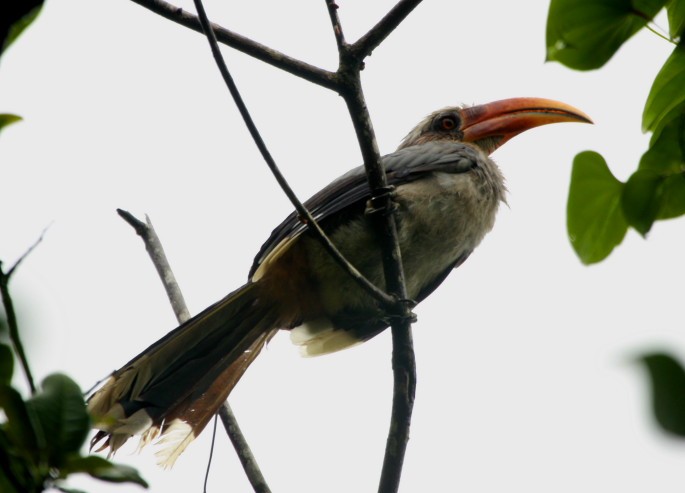Malabar Grey Hornbill
A species of South Asian Gray Hornbills Scientific name : Ocyceros griseus Genus : South Asian Gray Hornbills
Malabar Grey Hornbill, A species of South Asian Gray Hornbills
Botanical name: Ocyceros griseus
Genus: South Asian Gray Hornbills
Content
Description General Info
 Photo By Balakrishnan Valappil , used under CC-BY-SA-2.0 /Cropped and compressed from original
Photo By Balakrishnan Valappil , used under CC-BY-SA-2.0 /Cropped and compressed from original Description
The Malabar grey hornbill is a large bird, but at 45 to 58 cm (18 to 23 in) in length it is still the smallest of the Asian hornbills. It has a 23 cm (9.1 in) tail and pale or yellowish to orange bill. Males have a reddish bill with a yellow tip, while the females have a plain yellow bill with black at the base of the lower mandible and a black stripe along the culmen. They show a broad whitish superciliary band above the eye, running down to the neck. They fly with a strong flap and glide flight and hop around heavily on the outer branches of large fruiting trees. They have brown-grey wings, a white carpal patch and black primary flight feathers tipped with white. The Indian grey hornbill, which is found mainly on the adjoining plains, is easily told apart by its prominent casque, and in flight by the white trailing edge of the entire wing. The Malabar grey hornbill has a grey back and a cinnamon vent. The long tail is blackish with a white tip, and the underparts are grey with white streaks. The long curved bill has no casque. Immature birds have browner upperparts and a yellow bill. Young birds have a dull white or yellow iris. Their loud calls are distinctive and include "hysterical cackling", "laughing" and "screeching" calls. 
Size
45 cm
Nest Placement
Cavity
Habitat
The malabar Grey Hornbill predominantly resides in moist deciduous and wet evergreen forests, favoring areas with a rich presence of fruiting trees, especially figs. These birds adapt to a variety of forested landscapes, including riverine vegetation in drier areas, agroforestry plantations, and home gardens near forests. They are frequently found in forest fragments, sacred groves, and particularly thrive in dense tree stands within preserved wet evergreen forest regions.
Dite type
Herbivorous
General Info
Feeding Habits
Bird food type
Behavior
This hornbill is found in small groups mainly in habitats with good tree cover. Being large frugivores, they are important as seed dispersal agents for many species of fruit bearing forest trees. They also feed on small vertebrates and in captivity they will readily take meat. 
Distribution Area
The species is endemic to the Western Ghats mountain range of India from about Nashik in the north to the southernmost hills[1]. The species has an elevational distribution range from about 50 m near the coast (e.g., Phansad Wildlife Sanctuary, Maharashtra) to around 1,500 m in the mountains. In the southern Western Ghats, Malabar Grey Hornbills were reported in evergreen forests between 500 m and 900 m (sporadically to 1,100 m) elevation in Kalakad – Mundanthurai Tiger Reserve, but frequently up to 1,200 m in the Anamalai Hills further north. In both these sites, the estimated Malabar Grey Hornbill density decreased with elevation, with the population density in rainforest fragments in the Anamalai Hills being additionally positively related to food tree species richness. The species is found mainly in dense forest habitats; the thinner dry forest habitat of the plains is typically occupied by the Indian grey hornbill. The Sri Lanka grey hornbill was included with this species in the past, but is now considered distinct. 
Species Status
Not globally threatened.